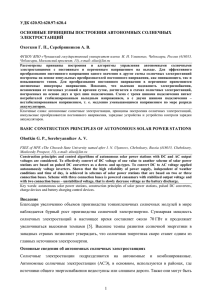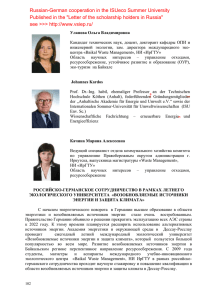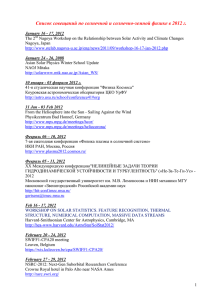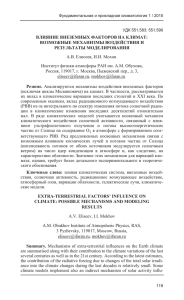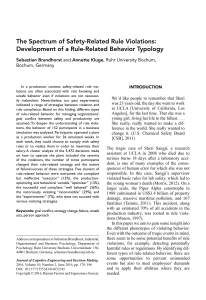Слайд 1 - Carnegie Endowment for International Peace
реклама
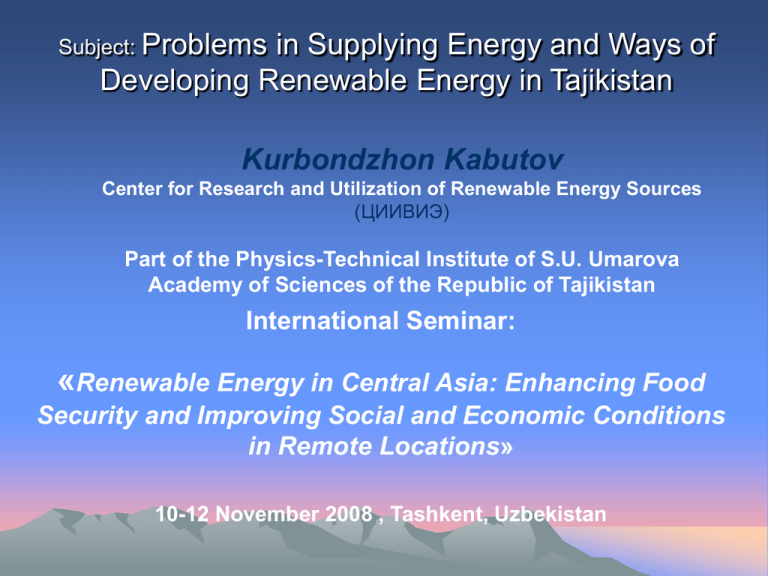
Subject: Problems in Supplying Energy and Ways of Developing Renewable Energy in Tajikistan Kurbondzhon Kabutov Center for Research and Utilization of Renewable Energy Sources (ЦИИВИЭ) Part of the Physics-Technical Institute of S.U. Umarova Academy of Sciences of the Republic of Tajikistan International Seminar: «Renewable Energy in Central Asia: Enhancing Food Security and Improving Social and Economic Conditions in Remote Locations» 10-12 November 2008 , Tashkent, Uzbekistan Contents of Presentation • The presentation includes an analysis of energy resources (both renewable and nonrenewable), and the possibilities and prospects for using renewable energy sources. • Experiences in research and utilization of renewable energy sources in Tajikistan (installation and devices that use renewable energy sources). • Strategy and Priority- the direction of policy towards renewable energy use in the Republic of Tajikistan. • To state the principal objectives of the government program “On approval of a comprehensive program to target the widespread use of renewable energy sources, such as the energy of small-rivers, solar, wind, biomass, and underground sources for 2007-2015” • Conclusion and Recommendations Traditional Energy Sources of Tajikistan Fuel Resources • Coal. Predicted coal reserves in Tajikistan are estimated to be 4-5 billion tonnes, and industrial and prospective reserves for coal deposits are 1 billion tonnes. It is necessary to use the latest extraction and raw material processing technology in order to avoid harming the local ecology. • Oil and Gas. Of the energy resources of Tajikistan, oil and gas makes up around 3%. Assumed depths of deposits of productive oil beds are 6000 meters or more. Hydro resources: • Potential resources of Tajikistan make up more than 500 billion kWh, currently 5% is realized. Tajikistan’s Energy Resources Energy Resources mill. t.f.e. (tonnes of fuel equivalent) • Oil 37.0 • Gas 15 • Hydro 64.7 (per year) • Coal 867.3 • Renewable Energy Sources - ??? Map of Tajikistan’s power supply system • ГЭС= hydroelectric station • ТЭЦ= thermal power plant Problems with supplying energy and ecology Problems. • A critical shortage of organic fuel, difficulty in delivering it to the mountainous regions of Tajikistan, continuous increase in price for electric power, and lack of electric power in many places that are far from main power lines, all force inhabitants of mountainous regions to use wood for fuel. This causes the destruction of otherwise scant woodland, whose area has already decreased 5-10 times, and in certain parts of the wooded areas have completely disappeared. The stripping of mountainous slopes leads to an increase in mudslides, soil washing away on slopes, and as a concluding consequence desertification, essentially causing a double greenhouse effect. Renewable Energy Source Potential (1) 1. Potential for small hydropower • The potential of small and mid-size rivers of the Tajik Republic is greater than 30 million kW and their annual electricity output is about 100 billion kWh per year. • On the inflow of the river, in the mountainous region of the Republic, it is technically possible and economically appropriate to build more than 1000 small hydropower stations with a power capacity ranging from 10 to 3000 kW. • The technical assessments and cost estimates for 14 prospective small hydropower stations show that their average annual output can be 348 million kWh with a total capital investment of $44 million. Renewable Energy Source Potential (2) 2. Solar Energy • The average total length of sunlight per year is 25003000 hours. The places that see a minimum amount of sunlight are- the mountain station of Dekhavz (2097 hours) located in the upper reaches of the Zarafshan River at a height of 2500 meters and on the Fedchenko Glacier that has a height of 4169 meters and gets 2217 hours. The maximum length of sunlight (more than 3000 hours) is found in the southern part of the Republic (meteorological station Pyanj- 3029 hours), and also in Eastern Pamir (meteorological station Karakul’- 3166 hours). Renewable Energy Source Potential (3) 2. Solar Energy • The total solar radiation on a clear day reaches 7500-8000 МJ/ sq. m. • Assessments show that solar energy can meet 60-80% of the needs of the country’s population for 10 months of a year. Converting this to its fuel equivalency brings this number to equal about 400,000 tonnes of fuel equivalent, which would equal 460 million cubic meters of gas or 528,000 tonnes of fuel oil. Renewable Energy Source Potential (4) Wind Energy • The strongest winds are in the highland areas with open forms of reliefs (Fedchenko Glacier, Anzobskiy Pass, and others) and in those areas where orographic factors have served conducive to increased pressure gradients (Khudzhand, Fayzabad, Shuroobod). • The average annual wind speed in these areas reaches 5-6 meters/second. In open plains and in wide valleys, wind speeds are somewhat slower- 3-4 meters/second. • In closed basins and in lowlands in the southern regions wind speeds do not exceed 1-2 meters/second. Renewable Energy Source Potential (5) Biomass • From the total amount of biomass available only 0.5% is consumed by humans in the form of food. • The use of biofuel in the form of firewood, manure, and leafy tops of rooted vegetables are of paramount importance to about 50% of domestic households around the planet, supplying energy from these sources and creating in total around 300 GW. • Biogas generator (methane tank) with a volume of 2 – 3 м³ that uses about 8 kg of manure daily (from four cows) makes up to 2 м³ of biogas per day. This is equivalent to a continuous output of 300 W of thermal energy. Appraisal of renewable energy sources and possibilities for their use • • • • • Small rivers Solar Biomass Wind Geothermal Sources Laboratories and experience for researching and using renewable energy sources in Tajikistan (1) • Since 1980 in the laboratory of the Solar Radiation Engineering department of the Physics-Technical Institute of S. U. Umarova Academy of Sciences of the Republic of Tajikistan, there has been ongoing scientific research and experimental designs for creating cells and devices that use solar energy. • From 01.01.2008 the laboratory was converted into the “Center for Research and Use of Renewable Energy Sources” as a part of the Physics-Technical Institute of S.U. Umarova Academy of Sciences of the Republic of Tajikistan. Experience in researching and using renewable energy sources in Tajikistan (2) • There have been technological developments for producing solar water heaters that can make from 0.1 to 1 tonne of hot water (50-70 degrees Celsius) in the course of one daylight day. Production with a 1 sq. meter solar collector per unit is 80 to 100 liters of hot water Some samples of these devices have been created and tested. • Developed and produced solar kitchens, created to prepare food using solar energy. The product allows a family to prepare food twice a day. The temperature inside the device is 100-130 degrees Celsius. • There is currently ongoing research on solar panels that are used for converting solar radiation into electricity. Experience in researching and using renewable energy sources in Tajikistan (3) Devices for using renewable energy sources • Water heaters on testing sites (Dushnabe) • Water heater on federal radioactive waste storage site (Faizabad) • Water heater with an aluminum collector • Diagram and construction of aluminum collector • Solar kitchen: Photo and diagram • Windmills: on a testing site that is on a mountain (Siyakukh) • Photovoltaic cells and solar photovoltaic stations • Biogas installations Water Heater • Water heater 150 liters Aluminum collector Water Heater • Solar bath that holds на 300 liters • Steel collector that is made in Bratsk, Russia (testing site) Water Heater • Solar water heater with two panels that holds 500 liters • Steel collector that is produced in Bratsk, Russia (testing site) Water Heater Solar water heater for 350 liters (federal radioactive waste storage site, Faizabad) Water Heater • Solar water heater for 30 liters • Aluminum collector (demonstrational) Water Heaters • Solar water heater with two panels. Tank holds 120 liters • Is placed on top of a cafeteria of the Presidium Academy of Sciences of the Republic of Tajikistan Solar Kitchen • Students prepare food in a solar kitchen. • Effective volume is 6 liters. • In the background is the solar photovoltaic panel. • 1992 Solar Kitchen • Diagram Solar kitchen for 6 liters. (2 soldier’s pots are shown in the inside drawer) Temperature = 130 degrees Celsius 1992 Solar Kitchen • Solar Kitchen with an effective volume of 3 liters. • Temperature = 120 degrees Celsius Solar Kitchen • Same one Solar Kitchen • Same one Solar Kitchen • Solar kitchen with a flat concentrator and polyethylene walls. • Temperature = 100 degrees Celsius Solar Kitchen • Diagram, project Photovoltaic Cells and Solar Power Stations • Photovoltaic cells (in its casing) • Si & GaAs Photovoltaic Cells and Solar Power Stations • Photovoltaic cells with a concentrator (Fresnel Lens) Photovoltaic Cells and Solar Power Stations • Solar module (130 W Monocrystalline silicon) Photovoltaic Cells and Solar Power Stations Diagram (experimental device) Module Reflector N S (b) Fig 8 Three Cornered Prismatic Stand Wind Energy • symbol Windmills • Windmill 4 kW. testing site Siyakukh (height of 2500 м) Biogas • A family’s 5 tonne biogas plant (Vakhdat region) At the bottom is the generator. Electrical Energy for 500 W which works to produce biogas. Micro Hydropower station • Portable micro hydropower station 150 W Weighs 25 kg Experience in researching and using renewable energy sources in Tajikistan (4) International Cooperation • In partnership with the Academy of Sciences of the Republic of Tajikistan, the representatives of the European Commission in Tajikistan, obtained and installed in varying locations of Dushanbe and Kurgan Tube several solar water heaters that are meant to produce hot water as well as several solar photovoltaic modules for receiving electricity. This was done as part of the “Use of Solar Energy in Tajikistan” project. Strategy and Priority- the direction of policy towards renewable energy use in the Republic of Tajikistan. • The government of the Republic of Tajikistan, February 2, 2007, no. 41, approved, “Comprehensive program to target the widespread use of renewable energy sources, such as the energy of smallrivers, solar, wind, biomass, and underground sources for 20072015.” • Executing Program: Academy of Sciences of the Republic of Tajikistan, institution of higher learning, Ministry of Energy and Industry of the Republic of Tajikistan, Ministry of Agriculture, and Committee on Environmental Protection of the Republic of Tajikistan. • Stages and the deadlines for realizing the Program: 20072015 • stage 1 – 2007-2009; • stage 2 – 2010-2012; • stage 3 – 2013-2015. Realizing the PROGRAM (1) Goals and Objectives of the PROGRAM: • Creation, developing, and widely using prospective technology for producing electrical and thermal energy that comes from renewable energy sources. • Implantation of modern technology that uses renewable energy sources into the country’s energy balance. • To train engineers and highly-skilled specialists in the field of renewable energy sources. Realizing the PROGRAM (2) Creating Infrastructure • For successful realization of the PROGRAM it is necessary: - to organize a design bureau for developing, producing, and distributing components and renewable energy sources devices; - to create a construction and assembly organization; - to create a Scientific and manufacturing department. Realizing the PROGRAM (3) Legislative Base • In the Republic of Tajikistan it is necessary to adopt the law “On Alternative Sources of Energy,” which together with the current Program will form the necessary normative-legal, economic, and organizational foundation for widespread use of renewable energy. • It is necessary to offer incentives to both consumers and producers of renewable energy. • Should permit imports on preferential terms of equipment and the corresponding components that are needed for renewable energy use. • Should make favorable conditions for the creation of joint ventures for progressive production technology, producing modern cells and solar energy plants as well as other forms of renewable energy. Preparation of Specialists Preparation of engineers and highly-skilled specialists in the field of renewable energy. • Physics-Technical Institute of S.U. Umarova Academy of Sciences of the Republic of Tajikistan 1. Post-graduate, Internships. 2. Seminars and training on renewable energy with the Tajik general population and students. (with support and participation of the Aga Khana Fund (University of Central Asia), NGO “Radi Zemli” (Timur Idrisov), “Molodezhnyi EkoTsentr” (Yuriy Skochilov), Fund to support inistiatives, “Dastgiri” (Muazama Burkhanova), and others. Technical University of Tajikistan- Academy of M. Osimi 1. Students in the Energy Department are taking courses on renewable energy. 2. Through a European Union project, laboratories for researching renewable energy sources are available and an educational program has been developed that aims to train Master degree holders and engineers. Conclusions and Recommendations (1) • 1. Tajikistan has an immense reserve of energy resources. At the same time, it is impermissible to have a careless attitude towards them and to use these gifts of nature in a wasteful manner. • 2. The long-term politics of the supply of energy to the country must include a maximum and rational use of all forms of energy resources, while also making sure to consider using high performance technology to convert energy, supply energy, conserve energy, and protect the surrounding habitat. Conclusions and Recommendations (2) • 3. It is necessary to efficiently provide energy to the country’s population. Renewable energy sources present in the regions should be used first. • 4. At the same time, there exists a number of problems with the wide-spread expansion of renewable energy. In order to overcome these challenges the government and the international organizations assisting in the introduction of alternative sources of energy, must increase efforts to transfer modern technology as well as provide financial and legal support. • 5. This will enable not only to preserve the ecology of a mountainous country, but it will also improve the living conditions of the population and decrease the level of poverty. Literature • • • • • • • • • • • • 1. Гидроэнергетические ресурсы Таджикской ССР. Лениенград (С-П), Недра. -1965. 2. Мухабатов Х.М., Природно-ресурсный потенциал горных регионов Таджикистана, Москва, Граница, 1999, -335с 3. Твайделл Дж., Уэйр А. Возобновляемые источники энергии. -Москва, Энергоатомиздат, 1990. 4. Кабутов К., Каримов Х.С., Каримов У.Х., Ахмедов Х.М. Возможности использования экологически чистых видов энергии в Таджикистане. Межд. Симпоз. Рацион. Использ. и охрана природ. ресурсов горных территорий, Душанбе,1997, с100-101. 5. Каримов Х.С., Кабутов К. - Солнечная кухня (на англ. яз.). – Ж. Гэлиотехника, 1995, N 1-3, -С. 81-86, Ташкент (Узбекистан). 6. X. С. Каримов, Кабутов К., Дж. А. Чаттха, М. Ахмед, М. Али, М. 3. Акрам, А. М. Тахир, А. Идрис, С. Т. Али. Исследование параметров и характеристик модулей солнечной фотоэлектрической станции при различных условиях. ДАН РТ, Душанбе, 2002, т. XLV, № 9, с. 75-83. 7.Х.С.Каримов, К.Кабутов, Х.М.Ахмедов и др. Высокоэффективная солнечная фотоэлектрическая станция. Душанбе: ДАН РТ, 2006, Т.49, № 3, стр. 289-293. 8.Кабутов К. Об использовании возобновляемых источников энергии в борьбе с опустынивением. Бюллетень- Центральная Азия: проблемы опустынивания, 1998. стр. 9.Кабутов К., Ахмедов Х.М., Каримов Х.С. Возможности использования возобновляемых источников энергии в горных районах. Международ. Конф. Горные регионы Центральной Азии, Душанбе, 1999, с.209-211. 10.Кабутов К., Ботуров К. Социально-экологическое значение использования энергии малых рек. Матер.Науч-практич. Конфер. «Памир-источник пресной воды ЦА», стр.60-61, 28-29, июня 2003, Хорог, ГБАО, Таджикистан. 11.Абдурасулов А.А., Кабутов К., Ахмедов Х.М. Некоторые аспекты использования малой энергетики и проблемы устойчивого развития. Ж. Таджикистан и современный мир. 2005, № 5 (9), стр. 28-36. 12.Солнечная энергетика. Состояние, возможности использования и перспективы развития. Составители: Х.М.Ахмедов, Сакис Галигалис, А. Элназаров. –Душанбе: Дониш, 2007. 114 с., илл. 40. Thank you for your attention • Kurbondzhon Kabutov, candidate in Technical Sciences, director of Center for Research and Utilization of Renewable Energy Sources at the Physics- Technical Institute of S.U. Umarova Academy of Sciences of the Republic of Tajikistan ---------------------------------------------------------------------------• Address: 734063, Physics-Technical Institute of S.U. Umarova Academy of Sciences of the Republic of Tajikistan, Tajikistan, Dushnabe. 299/1 Ayni Street Tel.. (992372) 225017, Fax (992372) 2257916 E-mail:kabutov@tascampus.eastera.net kurbon47@mail.ru
